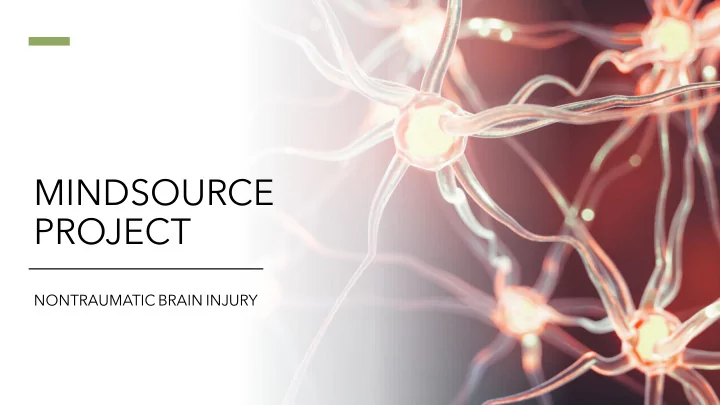

MINDSOURCE PROJECT NONTRAUMATIC BRAIN INJURY
NONTRAUMATIC BRAIN INJURY • A type of acquired brain injury that that is caused by an internal event Anoxic (total lack of O2) and hypoxic (partial lack of O2) -> cerebral hypoxia • • Including drowning, choking, suffocation, cardiac arrest, carbon monoxide poisoning, and complications of general anesthesia Neoplasms and Tumors • Infectious disease • Encephalitis and meningitis • Seizure disorders and epilepsy • Vascular insults • Including stroke, nontraumatic hemorrhages, and cerebral aneurysms • Toxic exposure • • Including substance use and heavy metals • Other Including cerebral edema, compression, hydrocephalus, and encephalopathy •
Objective 1: Prevalence • More difficult to determine than TBI as there are no cohesive databases nationally or in Colorado • Options to estimate prevalence: • Inpatient data • Emergency room visits • Ambulatory visits • Individual diseases • Disability
TBI Data • MINDSOURCE Hard to Serve Study 2017 • Craig Hospital research estimates over 250,000 adults in Colorado have a lifetime history of moderate or severe traumatic brain injury • Based on random digit-dialed telephone survey of 2,701 adults
Inpatient Data • ARHQ HCUP free use data • National data for every year • Colorado data from 2016 • Discharge rates, length of stay, cost to system, discharge status, demographics • Incidence not prevalence • Discharges ≠ people • Based on Diagnostic Related Groups (DRG) and ICD-10
Inpatient DRG Data Number of Hospital Discharges in 2016 Type of Brain United States Colorado Injury Infectious 52,355 764 Neoplasm 55,345 699 Vascular 541,415 6,139 Seizure 276,300 3,361 Other 16,650 195
Emergency Room Visits • ARHQ HCUP free use data • National data only • Number of visits, length of stay, costs, discharge status • Visits ≠ people • Incidence only but more years available • Based on ICD-10 codes • More inclusive
Ambulatory Visits • National Ambulatory Medical Care Survey (NAMCS) • National survey of community health centers • Data includes patient demographics, visit diagnoses, services and treatments provided • Visits ≠ people • Incidence not prevalence • National Hospital Ambulatory Medical Care Survey (NHAMCS) • National survey of hospital emergency and outpatient departments
Looking at types of injury separately • Anoxic Brain Injury • CO poisoning data 2017 in Colorado: 394 ER visits, 41 hospitalizations, and 38 deaths (Colorado Environmental Public Health Tracking) • Drowning: 74 drowning and submersion deaths in Colorado in 2018 (CoHID) • Neoplasms • 332 cases of brain cancer in Colorado in 2016 (CoHID) • Seizures • Prevalence of epilepsy in Colorado in 2015 was 56800 (MMWR) • Stroke • In 2017, the prevalence of people with a diagnosis of stroke in Colorado was 2.2% (Colorado BRFSS) and 1988 died from stroke (CDC)
Looking at types of injury separately • Data for each disease process is reported differently (or not reported at all) • Most of this data looks at incidence not prevalence
Disability • Prevalence of disability in 2012: 10% reported one or more disabilities (disabilitystatistics.org). • 1.8% reported a Visual Disability • 3.2% reported a Hearing Disability • 5.2% reported an Ambulatory Disability • 3.8% reported a Cognitive Disability • 1.9% reported a Self-Care Disability • 4.0% reported an Independent Living Disability • No data about etiology of disability
Objective 1: Prevalence Burden of Disease • Use annual data from ambulatory visits, emergency room visits and hospital discharges to determine burden of diseases that cause nontraumatic brain injury • Comparison to traumatic brain injury • Unable to assess if people these diagnoses actually have brain injury
Objective 2: Resource Mapping • Nontraumatic brain injury is too broad • Focus on individual categories (ie: stroke, seizures, anoxic injury, neoplasms, infections) • Online search for resources available • Use organizations such as Rocky Mountain Stroke center, Drennen’s Dreams Foundation, American Brain Tumor Association, etc • Standardized interviews with providers, care managers, social workers • Will follow model of resources currently provided by the Trust Fund for TBI
Objective 3 & 4: Impact • Sensitivity analysis based on how many seek MINDSOURCE resources and what is provided • Fiscal impact based on MINDSOURCE's current fund allocation
Recommend
More recommend